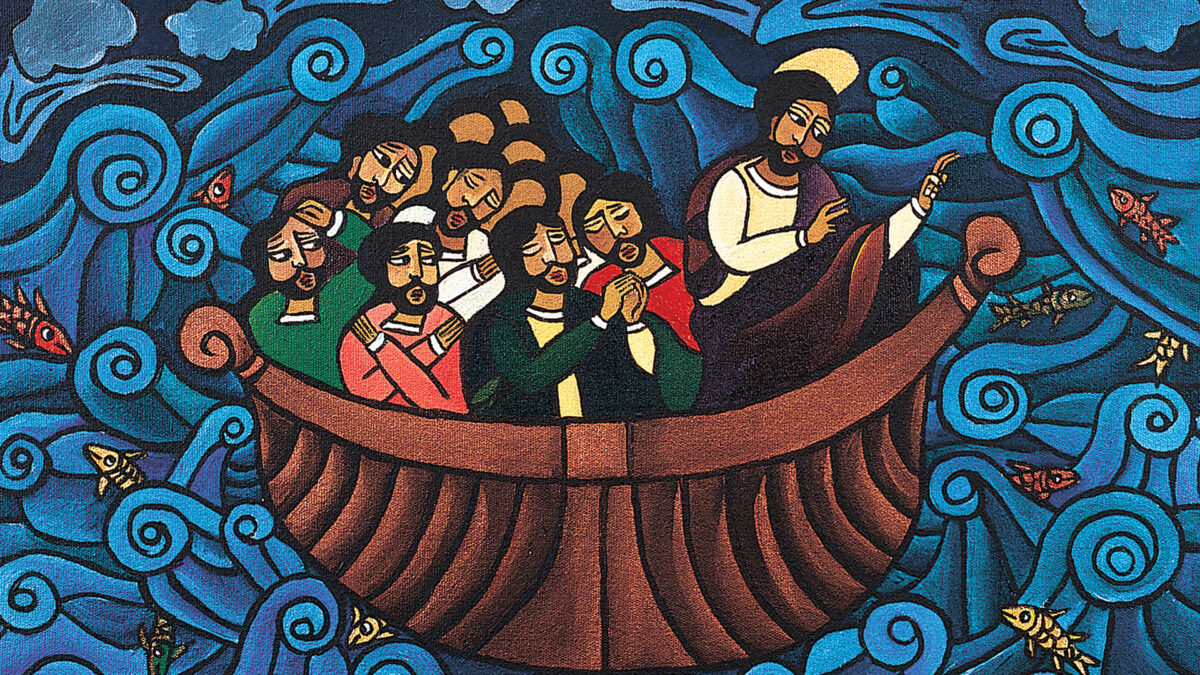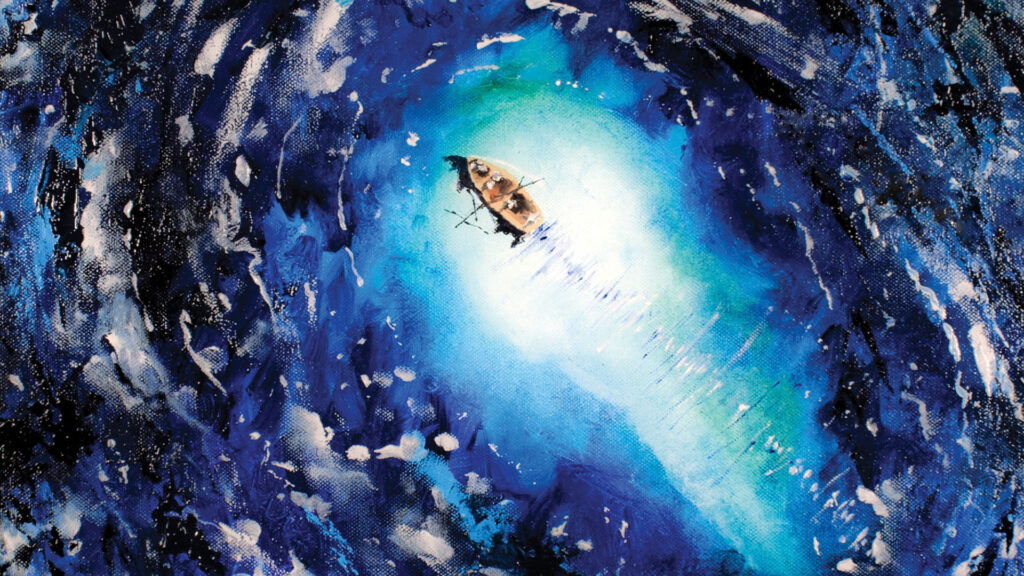Two takes on one of Jesus’ most enduring moments

Laura James
Jesus Calms the Storm
“The need to see yourself in your chosen religion is not a trivial thing,” says Laura James, a New Yorkbased painter and illustrator. “With my work I am trying to offer an alternative to the ‘traditional’ images we find in Western religious art.”
Perhaps the most striking element of Jesus Calms the Storm is her depiction of Jesus and His disciples. For anyone used to religious art depicting Christ and His followers as Anglo-Saxon in look, her portrayal of characters as dark-skinned individuals may be jarring to some but carries profound meaning.
“I grew up attending a Brethren church with my Caribbean family in Brooklyn, New York. We were not allowed to image Bible characters, and there was no art on the walls,” she says. “However, we did have children’s Bibles filled with fantastic images! Although surrounding characters were light brown in color, perhaps reflecting Middle Eastern people, Jesus was unbelievably White, with blond hair and blue eyes. The Black/African people were invariably odd shades of brown or gray, and often apelike. These images led me to believe this religion was at most not necessarily for me, a Black person, or at least did not respect Black people.”
Many years later Laura happened upon a book and remembers being struck by the images of Black angels on the cover. The style of art seemed simple enough to try to copy, so she took a chance with it. “At the time, I was interested in photography and hadn’t done much painting. But because everything was outlined in black and sort of looked like a coloring book, I managed to work it out. I am a selftaught painter inspired by Ethiopian Christian art and its long tradition,” she says.
Laura’s love of painting—specifically acrylic on canvas or wood—is further inspired by the feedback she receives from people who find renewed spiritual meaning through her pieces. They “appreciate the different colors of biblical characters represented in my work,” she says. After a long tradition of only seeing Christ and biblical characters represented by a look that doesn’t resemble people of color in the slightest, seeing oneself as part of the biblical narrative of the ministry of Christ can change a person’s entire outlook on His personal interest in their lives and love for them.
Jesus Calms the Storm has special personal meaning for Laura. “I’ve always liked the idea of Jesus keeping calm and steady as He taught unbelieving people, even as He did miraculous things!” she says. “As a big fan of water and the ocean, I was very happy to paint Jesus in this scene.”

Neil Thorogood
Calming of the Storm
“A lot of art begins with the Bible,” says Neil Thorogood, ordained minister and artist. “As a preacher I relish, and am constantly challenged by, the weekly opportunity to dwell upon Scripture and bring it alive for a congregation. The same starting point applies to art. I love the chance to begin with a text and let it grow into an image.”
Thorogood, who had never had any sort of formal art training, was exposed to it through his father, also an ordained minister. As his father carried a sketchbook wherever he went, Thorogood says he’s drawn and painted for as long as he can remember. He quickly found a way to incorporate art into ministry, “often creating large-scale installations as part of intergenerational worship and retreats,” he says. Master’s studies culminated in Neil combining art and theology. “My dissertation was a large-scale art installation exploring the Lord’s Prayer as an invitation to mission. From then on, I increasingly came to see myself as both a Christian minister and an artist. I discovered the joy of oils on canvas, which have become my primary medium, often on a large scale.”
“I believe the Bible is, all too often, a closed book for many within our culture,” Neil adds. “That can also be true within the church. Art can be a means to break it open in fresh ways.”
Calming of the Storm is a unique look at the story of Jesus commanding the waves to be silent in the face of His disciples’ terror. Rather than employing a traditional viewpoint, Neil portrays the story from an unexpected angle. “As I was wondering, back in the early 2000s, about a series on the Bible that I could keep adding to, I was drawn to the idea of images seen from the air. I love the ways in which so many photographers create stunning images from the air, and now, from space,” he says. “My hope is that this viewpoint invites people to stop and look a little more so that the story comes to them afresh.”
This particular piece, one of Neil’s most sought after, has been re-created in many versions. “It works well, in part, because the story itself is such a powerful one about being at the mercy of so much, then being saved by the Word and presence of Jesus. So the story resonates with many people’s own lives,” says Neil. “The image is powerful because of that sense of the tiny and fragile boat amid the vast and chaotic sea; it is the epitome of vulnerability.”
Religious art is all about the message and meaning in any given piece. For Neil, who is inspired by Rembrandt, Caravaggio, Stanley Spencer, Jackson Pollock, and Ron Mueck, the melding of meaning and medium (oil on canvas) creates a great energy when he paints. Calming of the Storm is a piece that exemplifies two of Neil’s great artistic loves: “The buttery nature of oils and the chance to mix color on canvas and let things emerge as the painting progresses.”
But it also goes deep into his soul. “I know dark times and profound fear and loss myself. This is an image that keeps wanting to say that all is never lost, and that God is at work even when we don’t see what is going on.”

Music and art offer different perspectives on the same story. Scan the QR code or go to www.adventistworld.org/imagine-this/.








